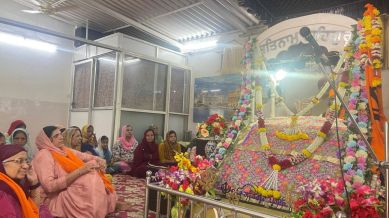Click here to join Express Pune WhatsApp channel and get a curated list of our stories
Hidden Stories of Pune: how a modest gurdwara grew to become an epicentre of Sikh faith in the city
Three ex-military men founded Gurudwara Dashmesh Darbar in Yerawada as a humble 10x12 ft tin structure. Today, the space can hold 100 devotees in the main hall, and over 300 people gather here on Sundays.

On December 20 and 21, a jatha from the Golden Temple in Amritsar will arrive at a small Gurdwara in Pune’s Yerawada to present kirtans to mark the martyrdom of the Chaar Sahibzaade, the four sons of Guru Gobind Singh. Gurudwara Dashmesh Darbar, situated close to the Bombay Sappers is gearing up for the event that is expected to draw a large number of devotees of different faiths from across the city. Martyrdom is an important sentiment at the gurdwara, which was founded by a group of ex-military men.
Unlike the well-known Gurdwara Guru Nanak Darbar in Camp, popularly known as the Hollywood Gurdwara, and Gurudwara Guru Singh Sabha in Ganesh Peth, the oldest gurdwara in the city, Dashmesh Darbar, is rarely talked about outside the community.
monthly limit of free stories.
with an Express account.
Unlike most gurdwaras, with their awe-inspiring architecture, Gurudwara Dashmesh Darbar is a humble structure with corrugated tin roof held up by metal pillars. On the path to the gate, one passes garbage and stray dogs. Gurudwara Dashmesh Darbar redefines the way we think about gurdwara architecture. Inside, there are boards that iterate the ethos of Sikhism, such as “Langar is Guru’s prasad. Kindly do not waste it”.
Established by 3 men in uniform
Its history goes back to three men in uniform who were united by their dedication to the nation – and the Sikh faith. Prithvi Singh Dhillon, a subedar in the Indian Army, who had come from Ludhiana; Inderjit Singh Gothra, from the Indian Air Force; and Puran Singh, who was with the Army, had families who had migrated to India during the Partition. Posted in Pune, they decided to make it their home.
“In 1957, the three cemented their relationship with Pune by setting up a small place of worship, Gurudwara Dashmesh Darbar, in Yerawada,” says Darshan Singh Dhillon, the president of Gurudwara Dashmesh Darbar and brother of Subedar Prithvi Singh Dhillon. Gradually, members of the Sikh community, who had retired or were retiring from services, began to set up homes around the gurdwara so that it became an epicentre of the community and nourished the Punjabi culture in Pune. Punjabi and Sindhi Punjabi parents who were looking for suitable matches for their sons and daughters would contact the gurdwara, which maintained a file of eligible youngsters. Weddings, among many life events, were held here.
Named after Dashmesh Pita
Gurudwara Dashmesh Darbar is named after Guru Gobind Singh, who was known as Dashmesh Pita as he was the 10th and last of the Sikh gurus. The gurdwara’s location, in a military area, is also reflected in the dedication to Guru Gobind Singh, a formidable force who had taken on Emperor Aurangzeb. Guru Gobind Singh had created the Khalsa Panth, the Sikh warrior force, in 1699 and introduced the five Ks – kesh, kangha, kara, kachera and kirpan – that became powerful symbols of faith, marking out members of the Khalsa and creating a bond among them.
Gurudwara Dashmesh Darbar began as a humble tin structure of 10×12 ft, where prayers were offered and events held on important days till the 1970s. “Originally, five or six families would come to offer prayers. They used to open the gurdwara in the mornings and close it. It would be opened again in the evenings. Subedar Prithvi Singh Dhillon was my elder brother. When I arrived in Pune in 1971, I was welcomed by the gurudwara which seemed to have a lot of visitors from the nearby military establishments. The number of people visiting for prayers kept increasing by the year,” says Darshan Singh.
Today, Gurudwara Dashmesh Darbar is a concrete structure that can hold 100 devotees in the main hall, where the Guru Granth Sahib is placed on a takhat or an elevated throne. Since space is a constraint, the open ground outside is used to set up marquees on important occasions, allowing more than 200 people to congregate at a time.
“On Sundays, we have more than 300 devotees visiting,” says Darshan Singh, adding that Guru Nank Jayanti, which falls on November 5 will be marked here on January 9, with special prayers and songs. “Thus, we ensure more footfalls as devotees can visit the different gurdwaras of the city on different days,” he adds.
Many children of former faujis have taken up corporate and other professions, so the crowd of faithful is a mix of civilian and military families. “Almost 70 years after it was set up, the gurdwara is still changing and growing the Sikh faith in Pune,” says Darshan Singh.
Click here to join Express Pune WhatsApp channel and get a curated list of our stories